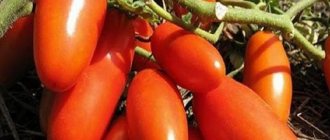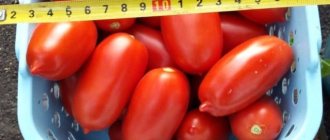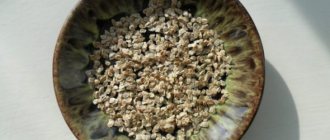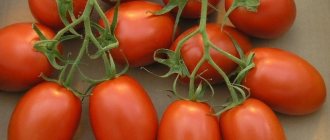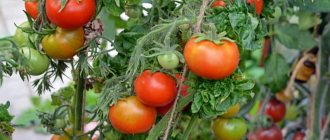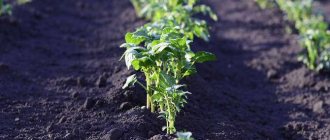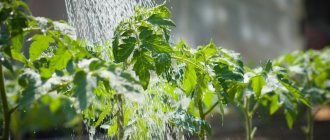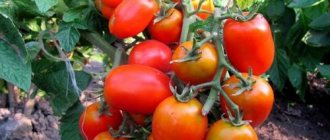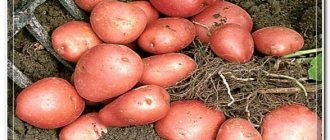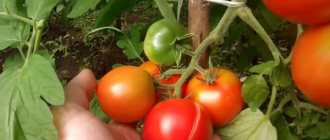| Ripening period: | mid-early, 98-100 days after emergence |
| Shape, weight of fruits: | flat-round, 200-210 g |
| Bush type: | indeterminate |
| Growing regions: | Northern, Northwestern, Central, Volga-Vyatka, Central Black Earth, North Caucasus, Middle Volga regions of the Russian Federation |
| Productivity: | 10 kg sq.m. |
The Big Beef tomato is one of those varieties that, once on the site, remain its permanent residents. Meaty, tasty, high-yielding, it has long left the southern regions of the country and is increasingly making its way to the north. The hybrid is a typical representative of beef tomatoes.
Characteristics and description of the hybrid
The hybrid became popular thanks to the work of breeders (Holland). Having passed the tests, the tomato was entered into the register of the Russian Federation in 2008 under number 9153817.
Being indeterminate, the height of the plant often reaches 2 meters. Formation can be carried out in two shoots, and both will produce excellent fruits, although many vegetable growers insist on one.
When describing the leaf blades of Big Beef, it should be noted that they are light green in color. Even strong nitrogen fertilizing is not able to change the color. The shoots are powerful, strong, they reliably hold large fruits. The inflorescence is simple.
Despite the fact that the registry assigned a weight of 210 g to the hybrid, those who have already grown this tomato claim that the weight of the tomato often reaches 350 g. Weighty fruits are formed not only on the first cluster, but also on subsequent ones.
Big Beef tomatoes bear fruit:
- flat-round and round;
- aligned;
- without ribbing or with a slight hint of ribbing;
- classic tomato type.
Ripening occurs smoothly, over the entire surface at the same time. Even an unripe fruit does not have a green spot on the stalk. Big Beef is bright scarlet. There are six seed nests, sometimes more. Pulp:
- juicy;
- dense;
- fleshy;
- thick;
- velvet.
The size of the tomato is such that cutting it crosswise can fully satisfy the needs of the sandwich. One ring is enough and Beef is ready for steak.
Vegetable growers fell in love with tomatoes for the unsurpassed taste of the fruit. As a rule, varietal tomatoes taste better, but Big abolished this axiom. The tasting rating “excellent” is well deserved. Tomato flavor:
- saturated;
- nice;
- with an impeccable balance of acids and sugars;
- a pleasant trail of aftertaste.
Big has a pleasant tomato aroma, for which we are also very fond of summer residents.
Big Beef tomatoes have a salad direction. Its skin is dense and elastic. To prepare salads, you need to heat the fruits. Once freed from the skin, Big holds its shape perfectly and is ready for consumption or processing.
The variety is great for juices and tomato paste. Tomato pulp is thick, which makes it possible to produce an excellent, flavorful product.
The yield is legalized for the variety within the range of 9.4-10 kg per square meter. m. However, vegetable growers from different countries say that getting a larger shaft is not at all difficult. Big Beef F1 tomatoes respond very well to the application of fertilizers and fertilizing. The variety has a marketable yield of 98%.
Big Beef tomatoes on video
If you grew Big Beef F1 tomatoes, please write whether you liked them or not. What was the yield and taste of the fruit under your conditions? Would you grow them again and recommend them to others? If possible, attach to the comment a photo of the entire bush as a whole or individual fruits that you grew. Thank you!
Your reviews of the Big Beef tomato and additions to the description will help many gardeners in an objective assessment of this hybrid.
You can see other productive tomato hybrids with photographs, descriptions and reviews in the F1 Tomato Catalog on our website.
Sowing and growing seedlings
It is better to sow in early March. In order for the shoots to be friendly and fast, you need to organize moist, warm heating. For this:
- the seeds are wrapped in damp cloth;
- placed in a plastic bag;
- sent to a warm place (24-26 ᵒC);
- stand for 3-4 days.
Sowing is carried out only with sprouted seeds. Under such conditions, seedlings appear on the 5-6th day. In this case, cultivation will proceed at a faster pace.
Tomato seeds are sown in pre-prepared soil. It should be:
- loose;
- free from weeds;
- nutritious;
- slightly alkaline or neutral.
The industry has taken care of vegetable growers by producing excellent universal soils for seedlings. They are tested for phytopathogenicity and enriched with nutrients. Seedlings in such soil grow quickly.
The resulting Biga shoots are strong. Already from the young plants it is clear that the beef will be powerful and tall. Caring for seedlings is no different.
Before emergence, the temperature should be within 25-26 ᵒC. After the sprouts appear, the greenhouse shelter is opened, the temperature is lowered by 3-4 degrees, but the illumination is increased. By choosing the brightest lighting for Big, you can prevent the seedlings from stretching.
When 2 true sheets appear, a dive is performed. This cannot be delayed. Intensive growth provokes severe overgrowth. Late picking leads to stress and stunted growth.
To plant plants proceed as follows:
- Prepare a container or disposable, individual cups.
- Fill them with the prepared earthen mixture.
- Compact.
- The lower part of the root of the tomato is separated and a cup is lowered into the soil.
- Press down the soil.
- Watered.
The plant quickly takes root and grows. To slow down the stretching, the temperature is lowered:
- at night - up to 16-17 ᵒC;
- during the day - up to 18-20 ᵒC.
Seedlings are ready for planting in open ground at the age of 50-60 days. As soon as the air temperature allows, and return frosts become impossible, transplantation is carried out.
Features of growing the variety
Big Beef F1 is grown from previously obtained seedlings. Planting material is purchased from a retail chain. Tomato seeds do not need disinfection; they went through all the necessary procedures before packaging. Seeds for seedlings are planted in early March using the following technology:
- The containers are treated with hot water with the addition of manganese.
- The substrate is used ready-made or compost is mixed with peat and sand, and nitrogen-containing fertilizer is added.
- Before laying in containers, the soil is thermally treated.
- Tomato seeds are deepened by 1.5 cm, maintaining a distance of 2 cm. Cover with substrate and water.
- The container is covered with film or glass, left in this form until germination, the soil is periodically moistened and ventilated.
When shoots appear, remove the protective material and provide the seedlings with a temperature of +23–25 °C
After 10 days, fertilize the tomato with Agricola.
Picking is carried out in small separate containers after approximately 25 days, when 6 leaves have formed on the tomato. The temperature is reduced to +18–20 °C, the lighting is left the same or increased up to 24 hours. Water at the first signs of drying out of the soil.
Tomatoes are transplanted into the greenhouse in early May, to an open area, when the night temperature has settled at +10 °C and above. The seedlings are planted in furrows at an angle, covered with soil up to the first leaves. No more than 3 copies are placed per 1 m² of area. When planting in one line, the distance between the tomatoes is 30–40 cm; if there are several furrows, then the interval between them is 0.5 m. When the tomato grows to 30 cm, it is hilled up and the mound is covered with mulch.
Agricultural technology Big Beef F1:
- It is necessary to fix the shoot to the trellis. The garter is carried out as it grows.
- Removing the stepsons, lower leaves and brushes from which the crop was harvested.
- Watering is carried out once every 10 days.
- Loosening is done every week.
- To prevent the growth of weeds, mulch materials are used.
The crop is fed with potassium fertilizers at the beginning of flowering, and with phosphorus fertilizers during fruit formation. Phosphate is used during the ripening period of the crop. Fertilize with liquid organic matter no more than once every 14 days, the procedure is carried out until the end of August.
Planting in the ground and caring for tomatoes
When replanting, you should be careful about choosing a good place in the garden. If tomatoes, potatoes or peppers were already growing on the site last year, it is better to abandon such a place. Neighborhood with these crops is also undesirable. It is better to plant Big after peas or cucumbers.
Soils for planting should be:
- lungs;
- fertile;
- with slight alkalinity or neutral.
When planting seedlings, it is advisable to bury the shoots. This will give additional roots and increase the feeding area.
Particular attention is paid to stepchildren. They all need to be removed when they reach a length of 1.5-2 cm.
Forming Big into one or two shoots will allow you to get a good harvest, but subject to regular, deep watering. Only with water can the plant absorb nutrients. Watering is carried out 3-4 times a week, 2-3 liters for each bush.
No matter how fertile the soil is, Big Beef needs feeding. During the growing season they need to be carried out at least 3 times:
- 2-3 weeks after planting. To do this, it is enough to use organic matter - dilute 1 kg of pig or cattle manure in a bucket of water. If you use chicken manure, the concentration is reduced by 2 times (0.5 kg of manure per bucket of water);
- As soon as the tomatoes enter the budding stage, add a tablespoon of potassium sulfate to the organic solution;
- 15-20 days after the second feeding, the third is carried out. You don’t have to use organic matter anymore, but potassium will make the fruits extraordinarily tasty.
The formation of a bush is constantly being done. Since Big is indeterminate, garters and attachment to supports are the basis for high-quality fruiting. You should not allow the shoot to sink under the weight of the tomatoes, this can lead to a break.
It is best to harvest when the fruits begin to turn brown. In this case, the acetylene released during ripening will not interfere with the growth of subsequent tomatoes.
Description and characteristics of tomato Big Beef F1, reviews, photos
Early maturing, indeterminate (unlimited growth), Dutch hybrid for greenhouses. The period from germination to the beginning of ripening is 99-105 days.
The bush is powerful, densely leafy, spreading, up to 1.8 meters high . We recommend tying to a support and pinching. It is best to form one stem, removing all the stepsons (side shoots growing from the axils of the leaves). The leaves of this tomato are large and light green. The inflorescence is simple.
Basic qualities of fruits
photo author Svetlana Kunakovskova
The fruits are round, smooth, dense, red in color at maturity, weighing 150-250 grams , good (for a hybrid) taste. These tomatoes have good keeping quality and transportability. Used for fresh consumption and processing into tomato products.
Productivity of the Big Beef hybrid : up to 4.5 kg of fruits from 1 bush (subject to agricultural practices).
Originator : Monsanto (Holland).
A site about tomato varieties with truthful reviews from gardeners - Tomatland.
Diseases and pests
Big Beef has excellent resistance to root-knot nematodes. Those gardeners who know about their problem with the parasite can completely trust Big and be happy with the harvest.
Beef is resistant to:
- viral tobacco mosaic;
- verticillium;
- fusarium.
Relatively resistant to late blight. Compliance with technological regulations in processing will allow you to obtain an excellent healthy product. If the humidity is high, then the first preventive spraying with fungicidal preparations should be carried out with the appearance of the ovary.
Advantages and disadvantages
The advantages of the Big variety are obvious:
- high marketability;
- large fruit;
- excellent taste;
- resistance to diseases.
Big Beef has unique properties to withstand weather disasters. The ability to pollinate under any conditions makes the tomato productive even in bad weather.
One drawback is the thick skin, which must be removed before use. However, the dense consistency of the pulp and the ability to keep its shape eliminates this drawback.
Similar hybrids
Several tomatoes are very similar to Big Beef:
- Steak. Developed by Russian breeders. The tomato is the same round, productive, tasty, red in color. When looking at photos, even experienced vegetable growers cannot always guess who is who. However, Beefsteak is not a hybrid, but a variety. You can select seeds from it and grow your own seedlings from year to year;
- Beef Bang. Developed by French breeders. The hybrid is very young (introduced to the register in 2018), but promising. Vegetable growers have not yet had time to get acquainted with this tomato and compare the yield and taste;
- Semko 25. The tomato is very similar to Big, but has a dark green leaf. Huge yield (up to 22 kg. sq. m.) can put the hybrid in first place. It is also characterized by increased resistance to diseases.

